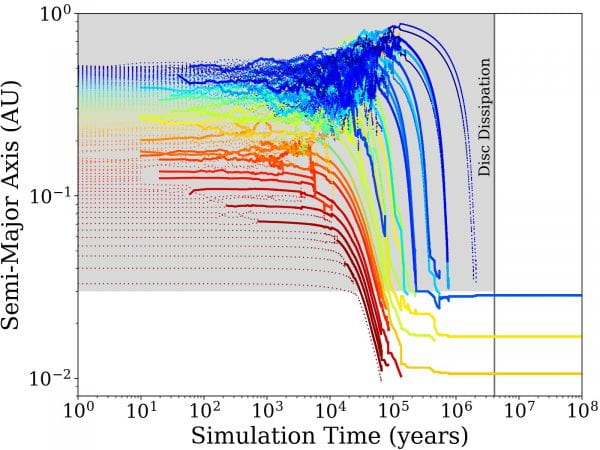Rapid Formation of Super-Earths Around Low-Mass Stars

Simulating the formation of super-Earths around M dwarfs
A recent study accepted for publication in the Monthly Notices of the Royal Astronomical Society explores the formation of super-Earth planets around M dwarf stars. CEHW graduate student Brianna Zawadzki, former CEHW postdoctoral researcher Daniel Carrera, and professor Eric Ford simulated the formation of planets around a star only 1/5 as massive as the Sun, investigating different initial mass distributions within the protoplanetary disk. The study considers the early stellar evolution of the M dwarf, including calculations for the changing stellar mass accretion rate and disk parameters. Although many planet formation models do not include these calculations, they are particularly important for M dwarfs due to the rate and length of their contraction onto the main sequence.
Understanding how close-in super-Earth planets form is crucial for fully understanding the planets discovered by missions such NASA’s Kepler and TESS. As we learn more about how these planets form, we gain deeper insights into their likely compositions, atmospheric characteristics, and other qualities which can be further probed with follow up observations. Still operating in its extended mission, TESS primarily targets short period planets around cool, low mass stars and is particularly well-suited to discover close-in M dwarf planets.
The study found that close-in super-Earths tend to form quickly around low-mass stars. Protoplanetary disks contain solids and gases that interact with each other throughout the formation process. The gas exerts torques on the solid mass, driving planet migration until the gas disk dissipates after several million years. A key result of the study is that most planets finished forming before gas disk dissipation. Considering inward migration past the inner edge of the gas disk and giant impacts that could remove an atmosphere, the study finds roughly a quarter of close-in super-Earths are likely to have an atmosphere that survived the formation process.

A typical simulation showing the collisions and inward migration of planets over simulation time. The gas disc dissipates after 4 Myr, at which point planets no longer experience inward migration. This particular simulation results in a system of 3 planets.
The authors also found that regardless of the initial conditions used, the distribution of mass at the end of the simulation appears to be completely different from the distribution of mass at the beginning of the simulation. Thus, it may be impractical or misleading to use an observed planetary system to infer the distribution of solids in a protoplanetary disk. The authors intend for this work to help motivate and inform follow-up studies of close-in super-Earths. Future work that expands on the range of M dwarf masses will provide further insight on how stellar mass affects the outcome of super-Earth formation. A preprint of the study can be found at https://arxiv.org/abs/2103.01239.
Credit: Brianna Zawadzki




